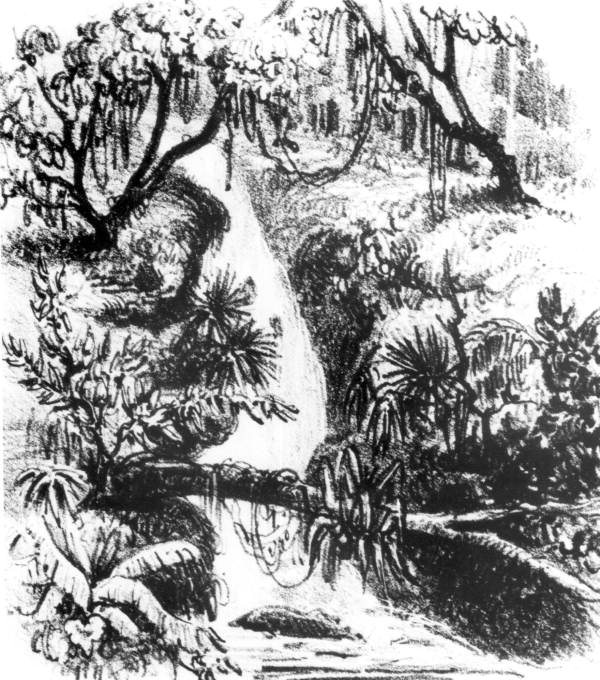By Doug Alderson

Drawing of Tallahassee Cascades by Castelnau around 1837-38
Many people who have heard the story of Tallahassee’s founding think of it as a simple affair. In order to create a central location for Florida’s capital and territorial legislature, merging the Spanish-created West Florida and East Florida, one emissary came from Pensacola and another from St. Augustine and they essentially met in the middle and … Tallahassee was born! It wasn’t quite as smooth as all that.
The two emissaries—Dr. William Simmons of St. Augustine and John Lee Williams of Pensacola were to first meet at the old Spanish fort at St. Marks. Simmons left St. Augustine by horseback on September 26, 1823, and followed well-established Spanish and Native American trails, arriving at St. Marks on October 10th. Williams, on the other hand, hired a captain and his mate with an open boat and they departed from Pensacola with no map or nautical charts on September 30th. He was accompanied by a Dr. Foster. Progress was slow and, not surprisingly, they became befuddled a couple of times such as when they entered the open mouth of St. Joseph Bay thinking it was Apalachicola Bay, causing a two-day delay. Once they entered Apalachicola Bay, they became stranded on St. George Island due to a storm. Once underway again, they traveled about 10 miles east of present-day Carrabelle whereby the captain refused to proceed any further because they were out of food. After what was likely a heated argument, Williams hopped out of the boat and proceeded by land, not knowing the terrain. He soon reached the wide Ochlockonee Bay. After scouting upriver, he determined that the only way to cross was by a raft made from driftwood. Surviving on oysters and crabs, he waited two days for the winds to calm before crossing the bay on the sinking raft.
Fortunately for Williams, the boat captain decided to meet him on the other side and take him to St. Marks. The captain probably realized that allowing a government emissary to perish on his watch was not in his best interest. After a day of rest and a quick trip to see Wakulla Springs since he had evidently heard about the famous springs, Williams finally met up with Simmons on October 27th, more than two weeks after Simmons arrived. “He [Simmons] had become very impatient and was thinking about setting out again for St. Augustine,” Williams wrote in his journal. This was likely an enormous understatement.
Williams and Simmons obtained horses and proceeded to the area of present-day Tallahassee and received reluctant permission to build the new Florida “council house” from Neamathla, the primary Seminole chief at the time. However, a nearby chief objected to the proposal. “He angrily caught up a handful of dirt, and presenting it asked if that was not his land,” wrote Simmons in his journal. After the meeting, Simmons’ concluding remarks on the area’s Native Americans were chilling and rather prophetic given what would follow in the subsequent decade. “From the behavior of this chief and other Indians whom we met, I am convinced these people will not be removed without difficulty,” he wrote.
Despite the mixed reaction to their visit, Williams enthusiastically advocated for the Tallahassee area to be the site for the new capital. “A more beautiful country can scarcely be imagined,” Williams wrote. “It is high, rolling and well-watered.” He also described a beautiful waterfall that fell 20 to 30 feet and was “sufficiently large to turn an overshot mill.”
Simmons wanted a site closer to St. Augustine, so the two investigated the lower Suwannee River and endured a harrowing and confusing journey. They ultimately agreed on Tallahassee. Based on their report, Florida Territorial Governor William Duval decreed on March 4th of 1824 that Tallahassee was to be the location of the new capital due to its central location and rich soils. Had Williams failed in completing his perilous journey from Pensacola, the march of history regarding the founding of Tallahassee might have turned out differently.
Doug Alderson is a Tallahassee-Leon County Bicentennial content provider for Visit Tallahassee and the Chair of the Bicentennial History Task Force. He is also the author of several award-winning books about Florida history and natural history.
